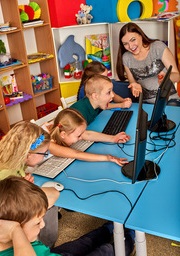Which Video Games Are Ideal for Your Child’s Development?
Looking for a way to encourage your child to be curious outside of school hours? You may be surprised to know that video games are a truly viable tool for learning. Video games may not be everyone’s first pick for an educational tool, as the term often conjures up images of zombies, shooters, and gore.
There are games like that, of course, but it’s not always the case. In fact, some video games can help your child learn more about a tricky subject than they might do in a traditional classroom setting. Skills like coding and problem-solving can be hard to learn for some children, but games like the ones shown in this list can make a huge difference.
Minecraft
To start, Minecraft is an incredibly popular sandbox adventure game with multiple ways to play and explore. If you feel that adventurous games would be a good fit for your child, this is the perfect pick for you.
While the base game in Minecraft might not immediately seem like an educational tool, playing it can actually help children to learn vital skills like problem-solving and creative thinking.
The crafting and engineering systems in the game are vast, and players will come across a number of issues they’ll need to solve without any specific instructions from the game. Tutorials are available, but the game encourages exploration and experimentation.
There’s even a specific version of the game for schools and businesses called Minecraft Education Edition. It teaches children about literacy, math, history, and coding, all in a fun and interactive format.
Baba Is You
Baba Is You is a fantastic indie game that’s best suited for players roughly aged eight and up. The gameplay offers a good blend of brain training and puzzle solving that requires some real lateral thinking.
One of the best things about Baba Is You is that it subverts what children may expect from a traditional game. Almost everything in the game can be interacted with, including elements like the walls surrounding a puzzle or the instructional text on screen.
It’ll push your child to think outside of the box and test their creative thinking.
If your child is younger than the recommended age, it could still be worth trying out this game and playing through it together. It’s a beautiful game with lovely graphics and music, and it’s clear that the development team put a lot of love into it.
Toca Lab
Toca Lab is much more of a niche game than the others on this list. This is a science-oriented educational game that focuses on the periodic table.
This game is cheery and colorful, and it has a light-hearted gameplay loop that makes an admittedly tricky topic much more approachable. If your child is struggling to remember scientific elements or write about them with confidence, this is a great game to check out.
Not only does this game look at scientific elements, but it also looks at different scientific tools and pieces of equipment. It’s a great introduction to what a science classroom can be like, which makes it a perfect pick if your child is just starting to focus on chemistry at school.
codeSpark Academy
If you’re looking to teach your child coding, codeSpark Academy is one of the highest-rated coding games on the market. It’s a bright and accessible title with a good mix of dedicated lessons and enjoyable puzzles with a coding theme.
Something that makes this game stand out from the crowd is that it lets children progress at their own pace. The lessons are self-led, and the games and puzzles are decently self-explanatory.
It’s no easy feat to make a difficult subject like coding feel accessible, but this game manages to do it nicely. If your child has been looking at coding in school but not finding much luck with it, this game could be the perfect solution.
Children can even build their own games through this app and share them with their friends, which is a brilliant way for them to see their work in action.
The game also has extra resources available to pair with the lessons, like workbooks.






 Author bio: Cora Gold is the Editor-in-Chief of women’s lifestyle magazine,
Author bio: Cora Gold is the Editor-in-Chief of women’s lifestyle magazine, 


